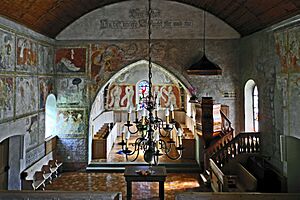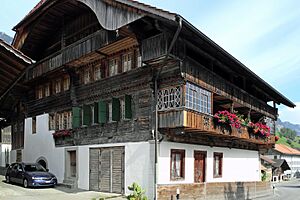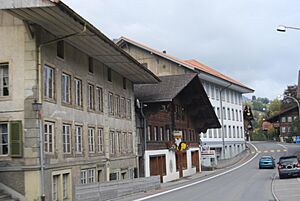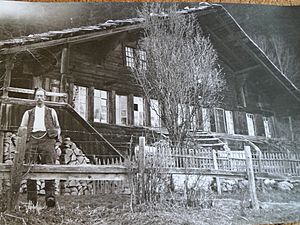Erlenbach im Simmental facts for kids
Quick facts for kids
Erlenbach im Simmental
|
||
|---|---|---|
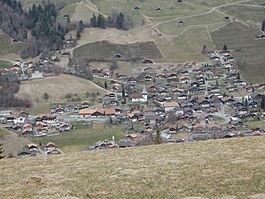
Erlenbach im Simmental village
|
||
|
||
| Country | Switzerland | |
| Canton | Bern | |
| District | Niedersimmental | |
| Area | ||
| • Total | 36.69 km2 (14.17 sq mi) | |
| Elevation | 700 m (2,300 ft) | |
| Population
(Dec 2020 )
|
||
| • Total | 1,724 | |
| • Density | 46.988/km2 (121.70/sq mi) | |
| Postal code |
3762
|
|
| Localities | Allmenden, Kleindorf, Latterbach, Ringoldingen, Stalden | |
| Surrounded by | Oberstocken, Niederstocken, Reutigen, Wimmis, Diemtigen, Därstetten | |
| Twin towns | Erlenbach, Zurich (Switzerland), Erlenbach am Main (Germany) | |
Erlenbach im Simmental is a small town, also called a municipality, in the canton of Bern in Switzerland. It's located in the Niedersimmental district.
Contents
Discover Erlenbach's Past
Erlenbach im Simmental was first mentioned in old records between 1180 and 1181. It was called Arlunbach back then.
Early Human Traces in Erlenbach
The very first signs of humans in this area are from the Paleolithic (Old Stone Age) period. These were found in the Chilchlihöhle cave. Later, Neolithic (New Stone Age) remains were discovered at Branteschopf Schwynbalm. Other ancient items, like those from the Bronze Age and Roman era, were found at Balzenberg and Unterklusi. A collection of Roman coins was also found at Stockhorn. Even after the Fall of the Western Roman Empire, people continued to live here. An old earthen fort at Chastel likely dates back to the Middle Ages. By the High Middle Ages, there were at least three castles or forts in the area, but only ruins are left today.
From Nobles to Cattle Trade
A noble family called the Freiherr von Erlenbach first appeared in records in 1133. When this family ended, their lands likely went to another noble family. Eventually, in 1368, the lands came under the control of the Freiherr von Brandis.
Starting in the 14th century, the Landsgemeinde, which was a direct democratic assembly where people voted in person, for the nearby communities met in Erlenbach. The villagers bought their freedom from taxes and forced labor (called corvée labor) from the Freiherr von Brandis in 1393, 1429, and 1445. When the city of Bern took over the villages in 1439, they confirmed these rights.
In the 16th century, people in Erlenbach started raising cattle. They kept the cattle in the valleys during winter and moved them to mountain pastures in spring. Over time, Erlenbach became a big exporter of cattle and cheese. Many locals became rich from this trade and built large, fancy wooden houses called chalets.
Fires, French Invasion, and Modern Growth
In 1765, a large fire destroyed much of the village. However, it was quickly rebuilt. After the French invasion in 1798, Erlenbach im Simmental became part of the Helvetic Republic district of Niedersimmental. In 1803, it rejoined the Canton of Bern.
In the 19th century, the Simmentalstrasse road connected Erlenbach to the rest of the country. Travel became even easier when the Spiez-Zweisimmen railroad opened a station in 1902. With better transport, the population grew, and businesses and tourism increased. In the 1970s, new housing areas were built above the village. Erlenbach now has a district hospital, a secondary school, and a nursing home. In 1987, the Agenstein House, built in 1766, became the Niedersimmental Region Museum.
The Village Church
The village church of St. Michael was first mentioned in 1228. It was probably built in the 11th century on the site of an even older church. The inside of the church was decorated with beautiful murals (wall paintings) in the 13th and 14th centuries. Many of these murals were repainted in the 15th century.
In 1330, the patronage rights (the right to appoint a priest) over the church were given to Interlaken Monastery. When Bern accepted the Protestant Reformation in 1528, the monastery was closed, and the church came under Bernese control. Before Bern officially became Protestant, the priest in Erlenbach, Peter Kunz, was already teaching the Reformation ideas in the village. He later became the pastor of the main Cathedral in Bern.
Erlenbach's Landscape and Location
Erlenbach im Simmental covers an area of about 36.73 square kilometers (14.18 square miles). A large part of the land, about 50.5%, is used for farming. Forests cover about 37.9% of the area. Buildings and roads make up about 3.5%, while rivers and lakes are about 0.9%. The remaining 7.1% is land that can't be used for farming or building, like rocky areas.
The municipality includes farming settlements called Bäuerten (small farming communities). These include Erlenbach, Latterbach, and Ringoldingen in the valley. Higher up, on a flat area above the valley, are the Bäuerten of Balzenberg, Eschlen, Thal, and Allmenden. Even higher up are alpine meadows, woods, and mountains.
On January 1, 2010, Erlenbach im Simmental became part of a new administrative area called Verwaltungskreis Frutigen-Niedersimmental.
Erlenbach's Coat of Arms
The blazon (official description) of Erlenbach's municipal coat of arms is: Argent, a castle embattled gules. This means it shows a red castle with battlements (the top part of a castle wall with gaps) on a silver background.
Who Lives in Erlenbach?
Erlenbach im Simmental has a population of about 1,700 people. As of 2010, about 5.1% of the people living here are foreign nationals. Over the last ten years (2001-2011), the population has changed slightly.
Most people in Erlenbach speak German as their main language (about 97.4%). A small number of people speak French (0.8%) or Serbo-Croatian (0.5%).
In 2008, about 49.1% of the population was male and 50.9% was female. Most people (about 39.2%) were born in Erlenbach. About 40.9% were born in the same canton (Bern), and 9.8% were born elsewhere in Switzerland. About 5.2% were born outside of Switzerland.
As of 2011, children and teenagers (0–19 years old) make up 20% of the population. Adults (20–64 years old) make up 60.1%, and seniors (over 64 years old) make up 19.9%.
In 2000, about 39.2% of people were single and had never been married. About 46.1% were married. The rest were widows, widowers, or divorced.
In 2010, there were 232 households with only one person and 45 households with five or more people. Most apartments (83.7%) were lived in all the time. Single-family homes made up about 46.9% of all housing in 2011.
The chart below shows how the population has changed over time:

Important Heritage Sites
Several buildings in Erlenbach are very important and are listed as heritage sites of national significance. These include the village rectory (the house where the priest lives), the Swiss Reformed Church, the Agenstein house, the Platz house, and the Ründi house. The entire village of Erlenbach im Simmental and the small community (called a hamlet) of Balzenberg are part of the Inventory of Swiss Heritage Sites. This means they are protected because of their historical and cultural value.
Famous People from Erlenbach
Erlenbach was the birthplace of Jacob Ammann. He was an important leader of the Amish movement, a group of Christian Anabaptists known for their simple living.
Erlenbach's Economy
In 2011, the unemployment rate in Erlenbach im Simmental was very low, at 1.05%. This means most people who wanted to work had jobs.
Jobs in Erlenbach
In 2008, there were 732 people working in Erlenbach.
- About 154 people worked in the primary economic sector. This includes jobs like farming and forestry. There were 52 businesses in this area.
- About 127 people worked in the secondary sector. This includes jobs like manufacturing (making things) and construction (building things). There were 25 businesses in this area.
- About 451 people worked in the tertiary sector. This includes jobs that provide services, like shops, hotels, hospitals, and schools. There were 59 businesses in this area.
Many people who live in Erlenbach also work there. In 2000, about 61.4% of workers lived and worked in the municipality. About 8.3% of workers used public transportation to get to work, and 60.7% used a private car.
Religion in Erlenbach
Based on the 2000 census, most people in Erlenbach (about 82.5%) belonged to the Swiss Reformed Church. About 6.1% were Roman Catholic. A smaller number of people belonged to other Christian churches, or were Islamic, Buddhist, or Hindu. About 3.22% of the population said they didn't belong to any church, or were agnostic or atheist.
Getting Around Erlenbach
Erlenbach im Simmental is on the Spiez–Zweisimmen railway line. This means it has train connections. There are two train stations in the area: Erlenbach im Simmental station and Ringoldingen railway station.
Erlenbach's Climate
Between 1981 and 2010, Erlenbach had an average of 140.9 days with rain or snow each year. On average, it received about 1308 millimeters (51.5 inches) of precipitation (rain or snow). The wettest month was July, with about 149 millimeters (5.9 inches) of rain or snow over 12.8 days. May had the most days with precipitation (14.6 days), but less total rain or snow (130 millimeters or 5.1 inches). February was the driest month, with about 86 millimeters (3.4 inches) of precipitation over 9.8 days.
Education in Erlenbach
In Erlenbach, about 57.3% of the population has finished upper secondary education, which is schooling after middle school but before college. About 13.4% have gone on to higher education, like a university or a Fachhochschule (a type of professional university).
The Canton of Bern's school system starts with one year of non-required Kindergarten. After that, students go to six years of Primary school. Then, there are three years of required lower Secondary school, where students are grouped by their abilities. After lower Secondary, students can continue their education or start an apprenticeship (learning a trade on the job).
During the 2011–12 school year, 220 students attended classes in Erlenbach. There were 2 kindergarten classes with 21 students. The municipality had 4 primary classes with 80 students. There were also 6 lower secondary classes with 119 students.
In 2000, 245 students who lived in Erlenbach also went to school there. Another 62 students came from other towns to attend school in Erlenbach. At the same time, 58 residents of Erlenbach went to schools outside the municipality.
See also
 In Spanish: Erlenbach im Simmental para niños
In Spanish: Erlenbach im Simmental para niños





